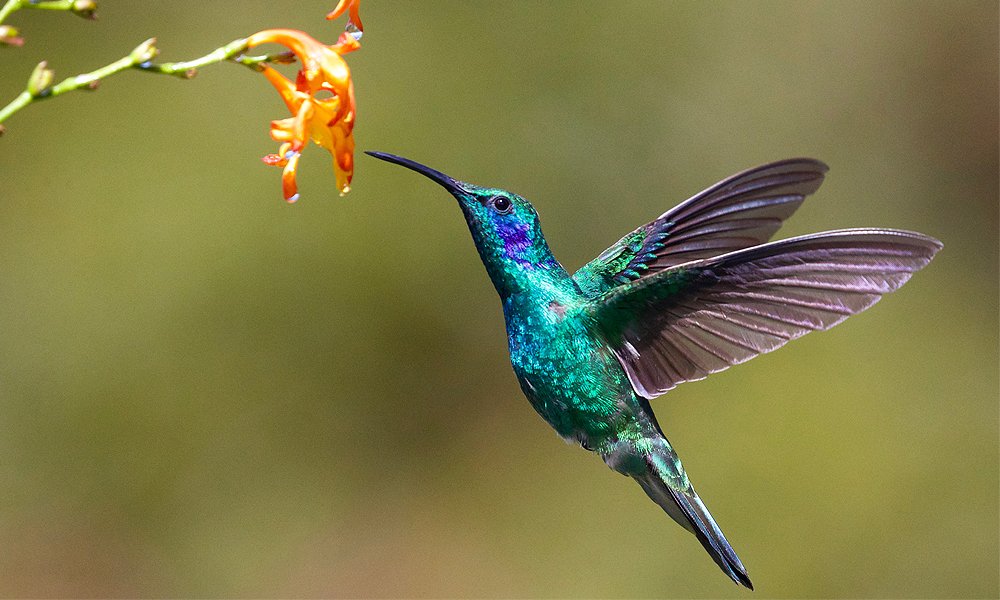Who doesn’t love hummingbirds? These jewel-colored beauties are a favorite visitor for gardeners and backyard birders alike. They pollinate flowers, so they’re good for your garden, and they’re gorgeous, so they’re good for your soul! And with 366 recognized species of hummingbird on earth, knowing how to attract hummingbirds can bring a whole bunch of variety into your life.
Although they do not travel in flocks, hummingbirds do tend to congregate in large numbers when a dependable food source is nearby, making it easy to use dependable strategies to attract hummingbirds to your yard in large numbers.
And as a bonus, many of the things that hummingbirds like are also things that enhance the natural beauty of your outdoor space. Make your yard more attractive with these tips and you’ll find that your garden is buzzing with hummers in no time.
1. Add bright red ribbon to your backyard
Flashy feathers aren’t just a part of a hummingbird’s plumage; color can play an important role in attracting them to your backyard. Like most birds, hummingbirds don’t have a great sense of smell and rely on vision to help them find food and a mate. Ever wonder why hummingbirds are so colorful? Bright colors help them recognize each other so they can attract a mate and fend off competitors.
Adding bright colors to your yard mimics the vibrant found in nature, with hummingbirds particularly preferring those in the red to the yellow range due to the structure of their eyes.
Ever wonder why hummingbird feeders are red? You guessed it! The bright red color is a hummingbird favorite that helps them recognize a food source. Knowing this, there’s lots of ways to put color to use in your garden so the hummers feel at home.
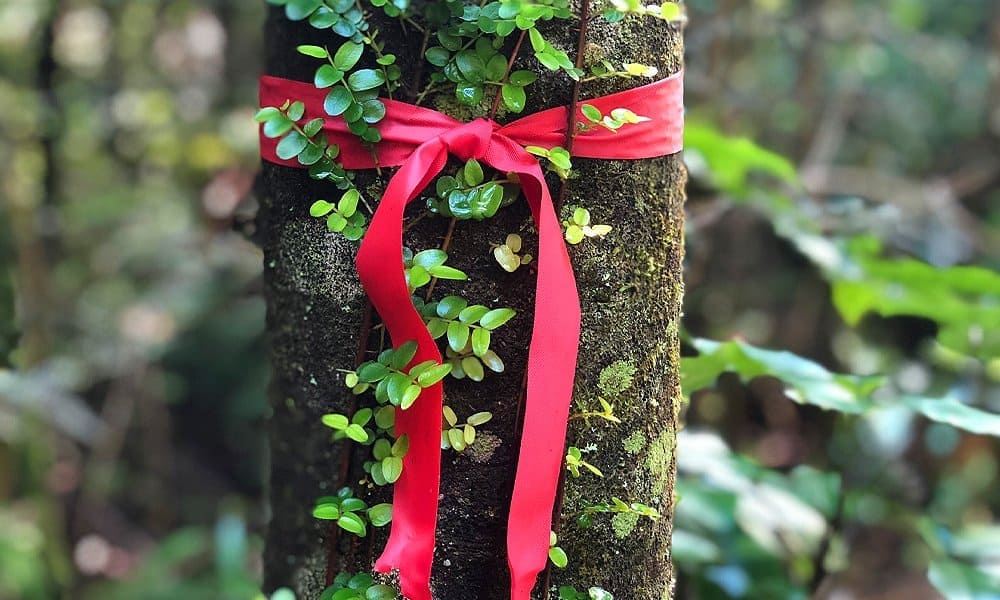
To catch the eyes of passing hummingbirds, tie bright red or orange ribbons anyplace near flowers or feeders. Surveyors tape is perfect for the task as it is easily available, comes in bright colors, and is made of durable plastic.
Tie it to your feeder pole or somewhere like a fence post to attract the hummingbird’s attention. The bright colors will lure the birds into taking a closer look. Then, finding your feeders and flowering gardens when they arrive, they’ll have plenty of reasons to stay in your yard. Just be sure to double-check that the materials you add to your yard are safe for hummingbirds and all your local wildlife.
2. Tempt with homemade nectar
It’s no secret that hummingbirds have a high metabolism. Just watching their wings buzz is enough to give that away, but the extent of their appetites is more than you might think. to keep those tiny wings beating, they actually need to eat approximately every 10 to 15 minutes.
Now you can probably imagine that an animal with that big of a hunger appreciates a good food source! Hummingbirds don’t just like feeders, they can’t afford to pass them up! If they discover that your yard is a safe and reliable place to eat, they’ll make themselves at home. Nectar feeders aren’t just nice to have; they are critical for hummingbird survival.
Suitable nectars can be purchased, but it can be hard to find hummingbird nectar that doesn’t contain harmful ingredients or unnecessary red dyes (the red color is good, but if your feeder is colorful, you really don’t need dyes for the solution, especially since evidence seems to point to red dyes harming the birds). Making a nectar solution is both easy and healthier for hummingbirds than store-bought alternatives.

Stay safe with this simple mixture of four parts hot water to one part sugar. Stir the mixture until the sugar is completely dissolved and cool to room temperature.
That’s it. Nothing extra, like added sweeteners or honey, is needed. Hot water is typically enough to dissolve the sugar, but boiled water is best and helps the mixture last longer (up to a week) when stored in your fridge. Just make sure it is completely cooled before you fill the feeder. Keep your feeders clean and sanitary and the hummingbirds will come back again and again to sample your sugar water buffet!
3. Install a perching spot
After beating your wings at a rate of nearly 80 beats per second, you’d feel like taking a break too. All hummingbirds, but especially males, like to perch both to take a break and to survey their territory. When they aren’t feeding, hummingbirds look for perches to rest and preen.
Some spots should be in the open and obvious for territorial birds, while others should be in protected areas, hidden from view and buffered from any cooler overnight temperatures — place feeders near trees and shrubs that provide perches as well as a natural food source.

You can add supplemental perches by adding small twigs to a brush pile, stringing a thin clothesline, or using slender poles, thin vines, trellises, wires, and multiple levels of shrubbery. Some even use accessories such as miniature swings to add instant perches to their yard.
You can also create a hummingbird snag by sticking a dead branch into the ground so that it stands vertically. Placed about 50 feet from your feeder, but still within view, and watch as hummingbirds use the perch to take a break.
4. Add hummingbird specific feeders
With one of the fastest known metabolisms of all animals, hummingbirds get quick energy from sugar-water feeders to fuel their search for insects and flowers to provide the rest of their nourishment.
Nectar feeders are one of the most common ways to attract hummingbirds to your yard and come in many different varieties. A wide range of styles are available, including glass bulbs, inverted tubes, and saucer dishes.

Many feeders may come with additional features meant to help your hummingbirds such as wasp, hornet, and ant guards. Feeders typically come with red parts as we’ve already explained that hummers love bright red colors. When picking the right hummingbird feeder, color is one thing to consider, but there are other factors that matter too.
The most important feature of any good hummingbird feeder is the ability to clean it, as they need to be cleaned regularly to avoid bacteria, fungi, and other harmful organisms.
5. Encourage nesting in your yard
Hummingbird nests are often built near a ready supply of nectar and other food. Encourage hummingbirds to nest in your yard by providing them with lots of their favorite options. They prefer small deciduous trees and dense shrubs to build nests and raise their family.
They construct their delicate nests on small horizontal surfaces, often using delicate materials such as lichens or spider webs. Unlike many other backyard birds, they will not use birdhouses or nesting boxes.

Instead, they build their double-lined, cup-shaped nests in trees and shrubs. Bolder birds may build their nests along wires, clotheslines, or poles.
Providing safety for your hummingbird friends in the form of shelter and native plants is key to attracting them to your yard. Birders can also supply suitable nesting materials, including fine natural cotton and animal fur, to further attract nesting birds.
6. Nurture beneficial insects in the yard
While most people only know these birds for their sweet tooth or tongue in the hummingbird’s case, they also eat a large number of insects, including spiders.
This essential protein source is especially critical during the nesting season when young hummingbirds need it the most for proper growth. Avoid pesticides or insecticides since this kills a significant source of potential food for your hummingbirds.
Bugs might be annoying in your garden, but when you welcome creatures big and small, nature tends to keep the balance for you. Letting bugs live without the intervention of harmful chemicals will encourage the birds that eat them, and pretty soon the bug population will be managed by nature’s own pest control!

In addition, choose flowering plants that are attractive to insects to provide a good natural food source for your birds. Spiders are particularly beneficial since they not only provide essential protein, but their cobwebs can provide a natural trap to catch other insects for hummingbirds to pluck.
Many birders “hide” rotting banana peels in their garden to set a natural fruit fly trap for their hummingbirds.
7. The location of the feeder is the key
As with most things, location is key. Hummingbirds are no different when it comes to preferences and experienced birders know that moving a feeder even a few feet can have drastic results on feeder popularity.
Hummingbirds have keen eyesight and will spot food sources naturally, but a little help is always appreciated. Place feeders close to areas naturally frequented by the birds, and follow other tips, like attaching red ribbons for utmost visibility.

Place your feeder outside of direct sunlight to keep the nectar and the birds cool. A bit of tree cover will also give hummers places to perch and shelter from predators. Feeders should be hung high enough that cats or other predators can’t attack and either very close or far away from windows to avoid collisions.
Hummingbirds will avoid feeding around larger birds, so position feeders away from other feeding stations, so they have their own space. A personal favorite is placing them close to windows, giving you more opportunity to enjoy these fascinating little birds.
8. Create a ‘hummingbird waterfall’
Like all birds, hummingbirds like to bathe, but you won’t usually find them at a traditional birdbath. These delicate birds prefer moving water or a much shallower source such as a mister or sprinkler for their delicate feathers.
Birders who provide water sources such as sprinklers, fountains, waterfalls, misters, and drippers will be rewarded with unique views of these remarkable tiny birds bathing and preening.
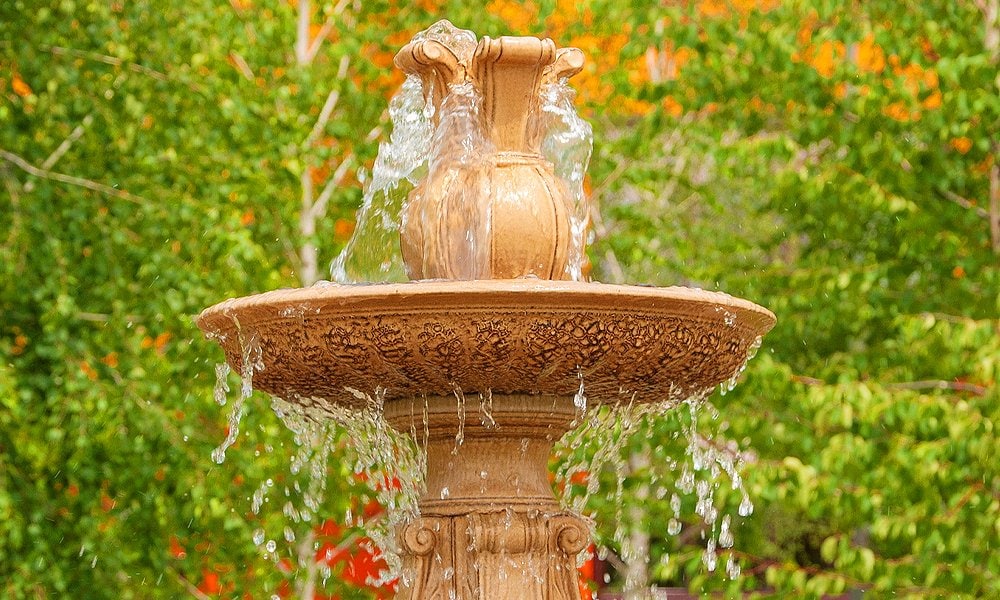
Misters are especially attractive to hummingbirds. You can also create shallow areas in traditional baths by adding pebbles or stones for hummingbirds to perch on. A regular birdbath is better than no birdbath, as hummingbirds will still stop by for a drink even if it is too deep to bathe.
Of course, all water sources should be kept fresh and clean for the health of your birds, and placing them near nectar-rich flowers can make the hummingbirds even more enticed to visit.
9. Lure hummingbirds with the right plants
To maintain their supercharged metabolism, hummingbirds need to feed nearly constantly just to survive. This means visiting between 1,000 and 2,000 flowers per day, so fill your yard with native flowering plants, vines, shrubs, and trees to attract more birds to your yard.
Some of the most common hummingbird attracting plants include bee balm, honeysuckle, cardinal flower, sage, and mandevilla. But the important thing is choosing flowers that are native to your region and pollinator-friendly. These will be the best flowers for attracting hummingbirds in the long term.
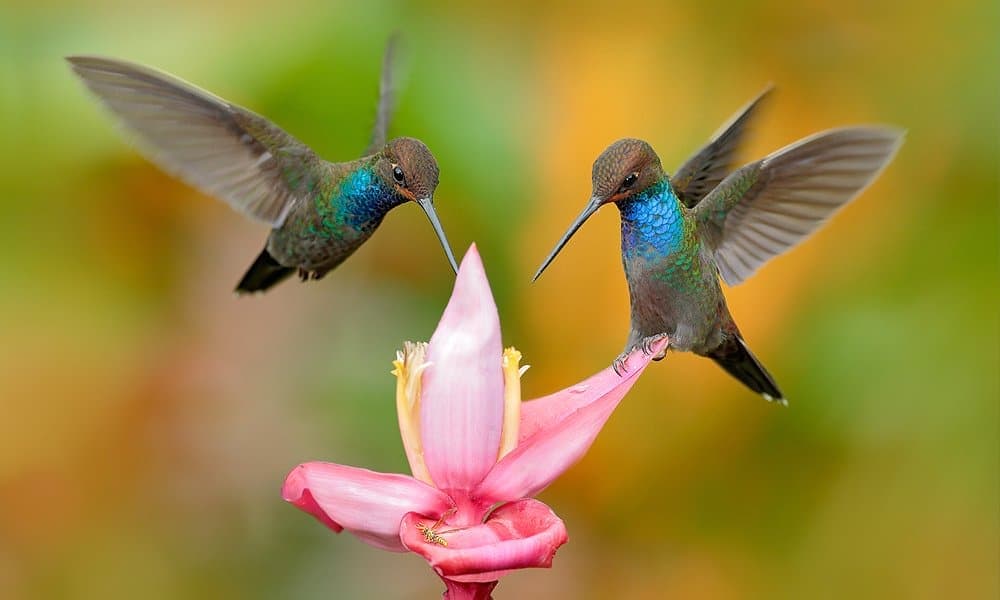
Regional lists of bird-friendly native plants for your area can be found online as well as utilizing local resources. Native plants are not only healthier for the environment, but often provide much more nectar than hybrids or exotics.
Group similar plants together and choose species with different blooming periods so that there will always be a steady supply of flowers. Encourage neighbors to make their yards hummingbird friendly as well; even one plant in a window box or hanging basket can help. This is less important than choosing native plants, but picking flowers with bright red or yellow colors can give add extra oomph to your hummingbird garden, since they tend to enjoy these colors.
10. Keep your feeders clean inside and outside
Fresh nectar will always be more attractive to birds than anything that has been left out and therefore started to sour. Change your sugar water every 3-4 days, but more if the weather is especially hot or humid.
Rinse and clean feeders every few days to keep debris, mold, fungus, bees, and ants away from the feeder; however, at least once per month, feeders should receive a deep clean.
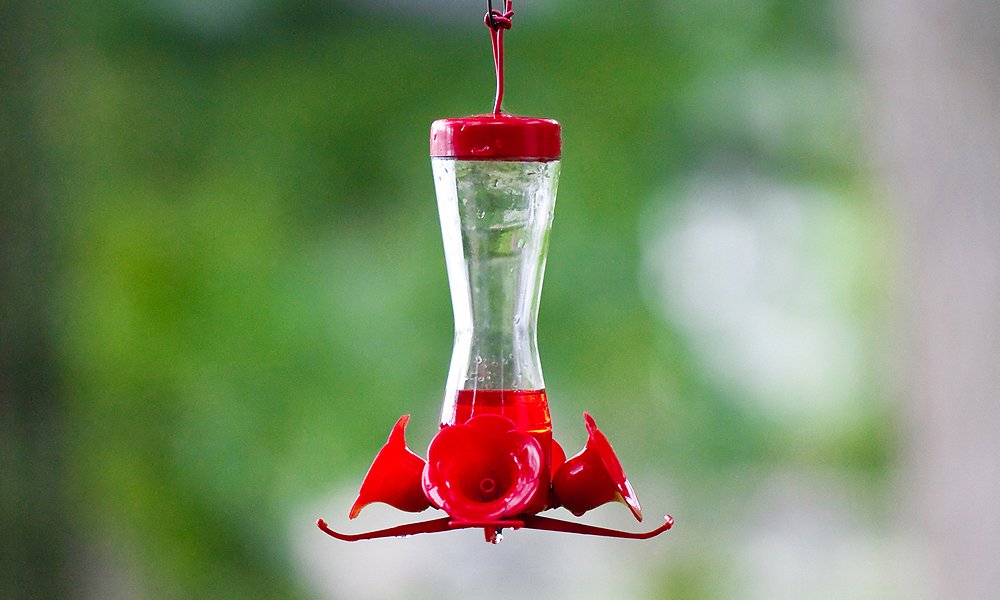
Soak your feeder in a weak vinegar solution and scrub as needed. Rinse well before refilling with sugar solution. Keeping the outside of feeder bottles clean also helps to make them sparkle, attracting the attention of hungry hummingbirds.
11. Keep the spider webs
Although you may not like them, fostering spiders will encourage hummingbirds to nest near your yard. Not only do their webs provide natural traps to catch other insects, providing a source of much-needed protein for the hummingbirds, hummers also use them to construct their expandable nests.
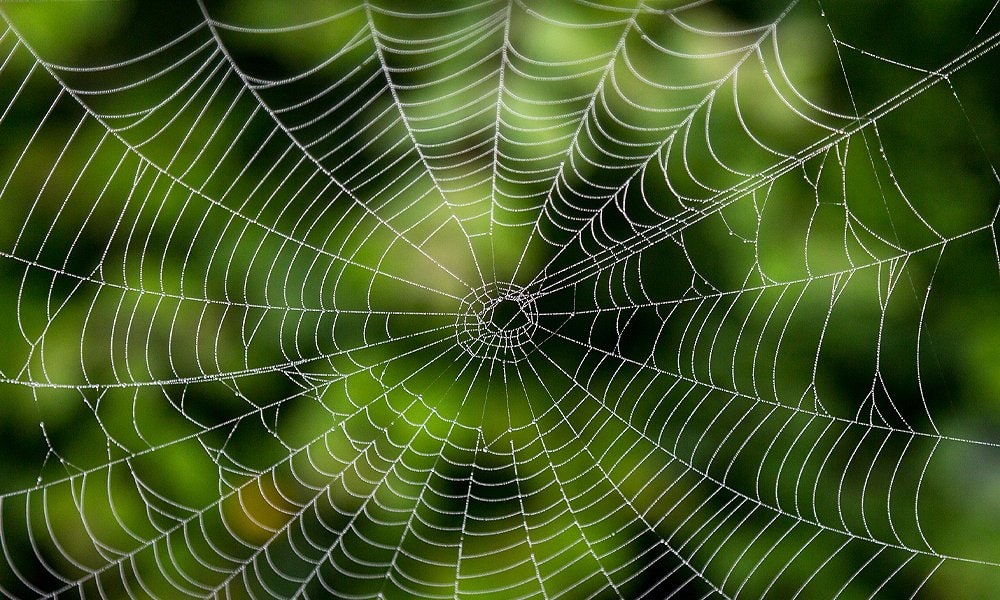
Hummingbird’s delicate nests are constructed of small bits of mosses and lichens, with strands of spider web holding the nest together and to the branch it’s built upon.
They use the spider silk as threads to both bind their nests and anchor them to their foundation. Keep the cobwebs in your yard to provide this favorite building material for nesting hummingbirds.
12. Trick the bullies
Hummingbirds might look cute and harmless to us, but they’re actually pretty ill-tempered and aggressive with each other. Males, especially, are very territorial around food sources and can become downright nasty to their fellow hummingbirds.
When many hummingbirds gather in a small area, this territorial behavior is often at its worst. Dominant birds chase others away, denying them a feed, and use up their own energy with their aggression. If you end up with a territorial bully, the presence of a hummingbird might paradoxically reduce the number of hummers visiting your yard. There are a number of things you can do to trick them.
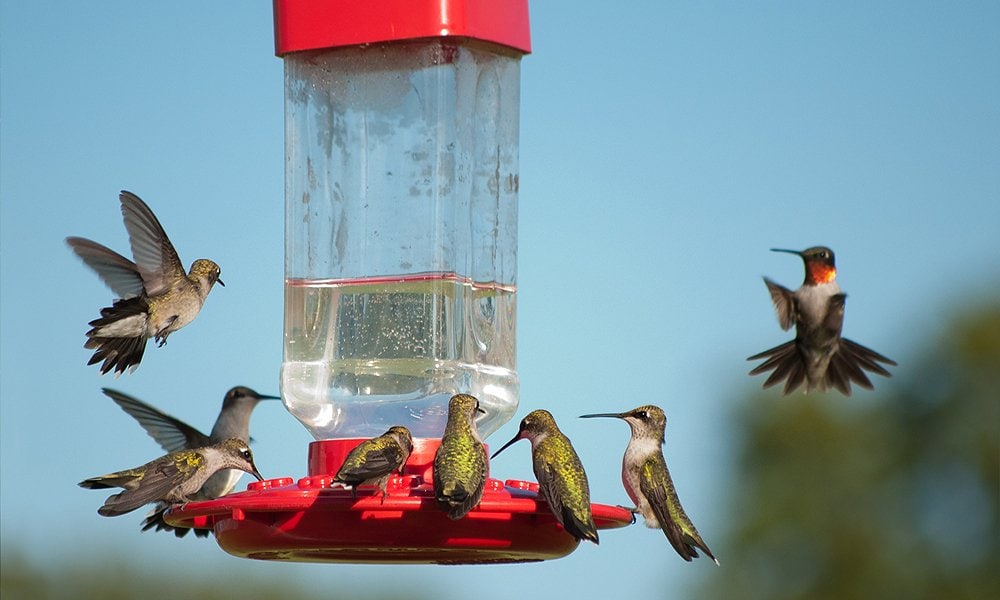
Use multiple bird feeders around your yard to eliminate the likelihood of the bully being able to defend them all. Other tactics include adding multiple feeders to a station to attract multiple hummingbirds.
This will quickly cure your bully of his territoriality since he will not be able to fight off all the other hummingbirds physically, so he will have to give up trying.
Remember not to interfere with the birds in any direct ways. Not only is it likely to reduce the presence of hummers in your yard, but depending on where you live it can be illegal. Enjoy the birds from a respectful distance and they’ll make themselves at home in your garden.
Final Thoughts
There is almost nothing as beautiful as a garden in full bloom with a crowd of buzzing hummingbirds zipping from flower to flower. I hope this guide has helped you turn your backyard into a hummingbird haven. When we act as friends and stewards of our local wildlife, we welcome joy and beauty into our lives. Happy humming!

